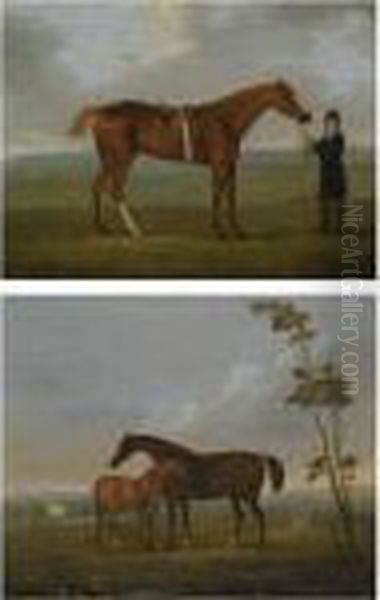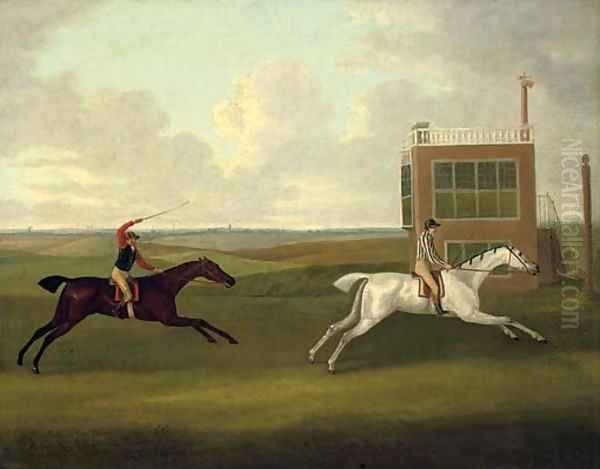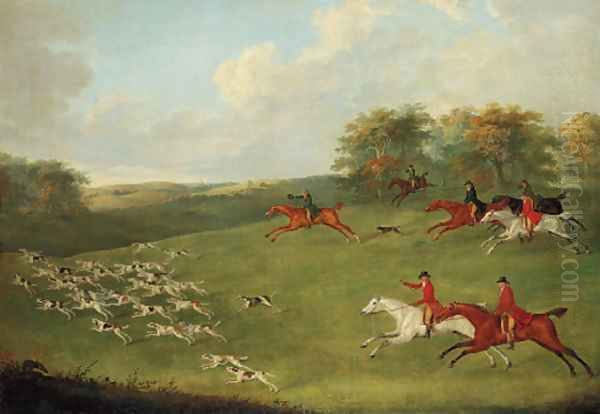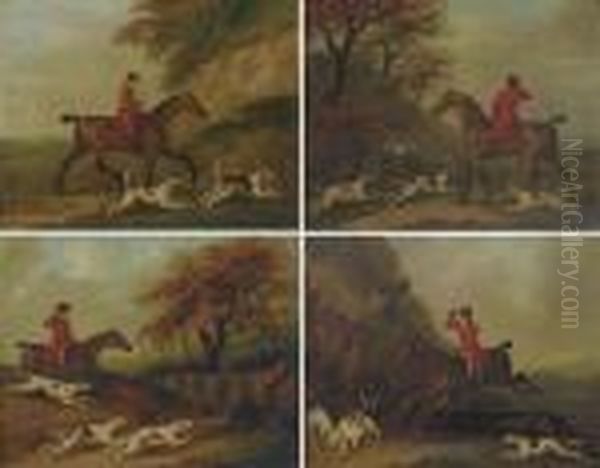Introduction: A Master of Equestrian Art
John Nost Sartorius stands as a significant figure in the annals of British art, particularly renowned for his mastery in depicting the vibrant world of equestrianism and field sports that so captivated the English gentry during the late 18th and early 19th centuries. Born in 1759 and passing away in 1828, his life spanned a period of great enthusiasm for horse racing, hunting, and the depiction of these pursuits in art. As a member of the celebrated Sartorius family, art was not merely a profession but a legacy, one he embraced and significantly contributed to, becoming arguably the most recognized painter of his lineage. His works offer a detailed and spirited window into the sporting life of his era, capturing the power of horses, the thrill of the chase, and the specific likenesses of celebrated animals and their owners.
The Sartorius Dynasty: A Sporting Art Heritage
The Sartorius name is synonymous with British sporting art, representing a dynasty that spanned several generations. The family's artistic roots trace back to the continent, with origins noted in Nuremberg, Germany. John Nost's grandfather, John Sartorius (c. 1700–c. 1780), established the family's reputation in England as a painter of horses, laying the groundwork for future generations. He specialized in portraits of hunters and racehorses for the landed gentry, establishing a style and clientele.
John Nost's father, Francis Sartorius (1734–1804), continued this tradition with considerable success. Francis was a prolific and respected artist, further cementing the family's association with equestrian subjects. He focused particularly on portraits of winning racehorses and hunters, enjoying patronage from prominent figures in the racing world. It was into this environment, steeped in the practice and appreciation of animal painting, that John Nost Sartorius was born and raised. He inherited not only the family name but also the artistic inclinations and likely received his primary training from his father, absorbing the techniques and thematic focus that defined their oeuvre. To distinguish his work from that of his father and grandfather, he often signed his canvases "J. N. Sartorius" or sometimes "J. N. Sartorius Jnr."
Artistic Development and Signature Style

Building upon the foundation laid by his father and grandfather, John Nost Sartorius developed a style that, while clearly part of the family tradition, possessed its own distinct characteristics. His work is noted for its lively and accurate portrayal of horses, capturing their anatomy, musculature, and, crucially, their movement with considerable skill. He excelled in depicting the dynamic energy of the racecourse and the hunting field. His compositions are often filled with action, whether it's the final dash of horses towards the finish line or the chaotic, exhilarating pursuit of the fox across the countryside.
Sartorius paid close attention to detail, rendering the specific markings of famous horses, the colourful silks of the jockeys, the attire of the huntsmen, and the features of the surrounding landscape with care. His use of colour was typically rich and clear, contributing to the vibrancy of his scenes. While perhaps not possessing the profound anatomical insight of his slightly earlier contemporary, the great George Stubbs, Sartorius was highly adept at narrative composition and conveying the atmosphere of sporting events. His style was less analytical than Stubbs's but arguably more focused on the immediate drama and social spectacle of the sport. Compared to predecessors like John Wootton or James Seymour, Sartorius's work reflects the later 18th-century taste for slightly more refined detail and composition, moving away from the sometimes stiffer, more decorative approach of the early Georgian period.
Masterpieces of the Turf and Chase
John Nost Sartorius was exceptionally prolific, and his output includes numerous portraits of celebrated racehorses and dynamic hunting scenes. Among his most famous works is the portrait of Eclipse (painted around 1780, though the horse retired undefeated in 1770). Eclipse was a legendary racehorse, unbeaten in his career, and a crucial foundation sire for the Thoroughbred breed. Sartorius's depiction captured the power and conformation of this equine icon, contributing to the horse's enduring fame.
Another significant work is his painting of Diomed (1780). This piece is particularly noteworthy as it depicts the horse winning the very first running of the Epsom Derby in 1780. Capturing this historic moment cemented Sartorius's reputation as a leading painter of the turf. The painting is considered one of his representative masterpieces, showcasing his ability to combine portraiture with the excitement of a major racing event.

His hunting scenes are equally characteristic and were immensely popular. Works like A Hunt in Full Cry exemplify his skill in this area. These paintings typically feature a pack of hounds streaming across the landscape, closely followed by huntsmen on horseback, often navigating fences and ditches. The energy and movement are palpable. A Hunt in Full Cry is noted not only for its artistic merit but also for having been in the possession of the British Royal Family at one point, indicating the level of patronage he enjoyed. Other hunting subjects, such as The Death of the Fox, Going Out (1797), and sets like A Pair of Hunting Scenes (painted over a period, c. 1795-1828), further demonstrate his dedication to this genre. He was also adept at painting hounds, as seen in works depicting specific dogs, like a greyhound and a brown hound mentioned in auction records. While horses and hunting dominated, he occasionally painted other subjects, including dogs and cattle.
A Prolific Career: Exhibitions and Publications
John Nost Sartorius enjoyed a long and productive career, firmly establishing himself within the British art scene of his time. He was a regular exhibitor in London, showcasing his works frequently at both the Royal Academy of Arts and the Free Society of Artists. Records indicate that he exhibited over one hundred paintings at these prestigious venues between 1778 and 1827, a testament to his consistent output and recognition by the art establishment. His presence at these exhibitions ensured his work was seen by potential patrons and fellow artists.
Furthermore, Sartorius reached a wider audience through the burgeoning popularity of sporting publications. He contributed significantly to The Sporting Magazine, a highly popular periodical that featured articles, news, and illustrations related to all forms of sport. It is recorded that he provided sixteen plates for the magazine between 1795 and 1821. These engravings after his paintings helped to disseminate his images broadly, making his name familiar to sporting enthusiasts across the country and beyond. His activity was also closely associated with Newmarket, the historic centre of English horse racing, where many of his patrons and subjects were based. This connection underscores his deep integration into the world he depicted.
Context: British Sporting Art in the Golden Age
John Nost Sartorius worked during a period often considered the golden age of British sporting art. The genre had gained significant traction in the early 18th century with artists like Peter Tillemans, James Seymour, and John Wootton, who catered to the aristocracy's passion for horses and hunting. The latter half of the century saw the emergence of George Stubbs, whose scientific approach to equine anatomy revolutionized the field. Sartorius operated in the wake of Stubbs, alongside other notable contemporaries who specialized in animal and sporting subjects.

These included Sawrey Gilpin, known for his romantic and often dramatic depictions of horses; Benjamin Marshall, often regarded as Stubbs's most talented successor, admired for his realistic portrayal of racehorses and the racing milieu; and George Morland, who, while more focused on rustic genre scenes, often included horses and depicted aspects of rural life that overlapped with sporting interests. Other artists active in similar fields during or overlapping Sartorius's career include Philip Reinagle, known for his sporting dogs and game birds; Abraham Cooper, who painted battle scenes as well as sporting subjects; and James Ward, a versatile animal painter and engraver, whose work sometimes engaged with the legacy of Stubbs. The tradition of hunting scenes was also vigorously pursued by artists like Henry Alken (both Senior and Junior) and the Dean Wolstenholme family (Senior and Junior), whose works often emphasized narrative and vigorous action, sometimes with a more stylized or anecdotal approach than Sartorius. Within this rich context, Sartorius carved out his niche as a reliable, skilled, and highly productive painter, particularly valued for his hunting scenes and portraits of specific, famous horses.
Influence and Artistic Lineage
The most direct artistic influence on John Nost Sartorius was undoubtedly his father, Francis Sartorius. He inherited the family's style, subject matter, and likely many of its patrons. In turn, John Nost Sartorius continued the family tradition, and his own son, John Francis Sartorius (c. 1775–c. 1831), also became a painter of sporting subjects, representing the fourth generation of the dynasty. While perhaps not as prolific or renowned as his father, John Francis ensured the Sartorius name remained associated with equestrian art into the early 19th century.
Beyond his immediate family, John Nost Sartorius's influence can be seen in the numerous copies and works painted in his style. Auction house catalogues occasionally list works by "Follower of John Nost Sartorius," indicating that his clear, detailed, and action-filled approach was admired and imitated by lesser-known artists. While his style was eventually perceived by some critics as becoming somewhat formulaic or 'old-fashioned' compared to the developing trends in British art in the early 19th century (such as the rise of Romanticism and changes in landscape painting), his work remained popular within its specific niche. His primary influence lay in his consistent production and the widespread dissemination of his images through engravings, which helped solidify conventions for depicting racing and hunting scenes.
The Enduring Appeal: Market and Legacy
The works of John Nost Sartorius have maintained a consistent presence in the art market, particularly among collectors of sporting art. His paintings regularly appear at major auction houses like Christie's and Sotheby's, as well as specialist dealers. Prices for his works vary depending on size, subject matter, condition, and provenance, but significant pieces, especially those depicting famous horses or particularly dynamic hunting scenes, can command substantial sums, often ranging from several thousand to tens of thousands of pounds sterling. For example, a painting of hounds was estimated at £7,000-£10,000 in a modern auction, reflecting solid market value. The royal provenance associated with works like A Hunt in Full Cry adds to their desirability.

The large number of engravings made after his paintings during his lifetime also contributed to his lasting legacy. These prints made his compositions accessible to a much wider audience than just the wealthy patrons who commissioned the original oils. They helped to popularize specific images and cemented his reputation as a chronicler of the turf and chase. His legacy today rests on his role as a key figure within Britain's most famous dynasty of sporting painters. He was a highly competent and incredibly prolific artist who accurately and energetically documented the horses, people, and activities central to British rural aristocratic life in his era. His paintings serve as valuable historical documents as well as engaging works of art, capturing the spirit and detail of a bygone age of sport.
Conclusion: A Dedicated Sporting Artist
John Nost Sartorius occupies an important and enduring place in the history of British sporting art. As the most prominent member of the Sartorius dynasty, he built upon the legacy of his father and grandfather to become one of the most sought-after painters of horses and hunting scenes of his generation. His prolific output, characterized by detailed realism, dynamic compositions, and a deep understanding of his subject matter, provided his patrons with faithful records of their prized animals and cherished pastimes. Through countless canvases depicting legendary racehorses like Eclipse and Diomed, and capturing the thrill of the hunt in vibrant detail, Sartorius created a rich visual tapestry of English sporting life at the turn of the 19th century. While artistic tastes evolved, his work retains its appeal for its historical significance, its technical skill, and its spirited celebration of the horse and the chase, ensuring his continued recognition and appreciation.